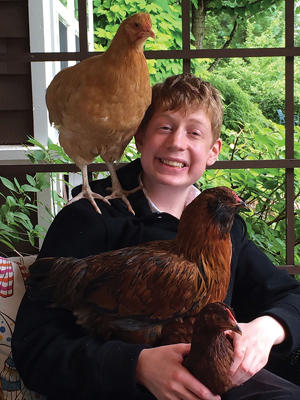
My son has little use for human conversation. Andrew has autism and he prefers to communicate through half-sentences, videos, pictures and the fine art of chicken whispering — the language he uses while playing with his favorite feathered friends, our pet chickens. Although their conversations often leave me baffled, the day I overheard him tell his favorite chicken that his body was trying to kill him, the message was crystal clear.
“The pain is twisty. Like this,” he said to Frightful, mashing his fists together in front of him, rotating one forward and one back. I was shocked, but the little hen regarded him with her kind, yellow lizard eyes, and I could tell she understood.
Soon afterward, Andrew developed a mysterious group of symptoms that lasted for as long as 10 days every month. High fevers, ulcers and unexplained pain brought us to the emergency room at Seattle Children’s Hospital on a regular basis. The doctors couldn’t determine the cause, and my 8-year-old son couldn’t describe his pain in ways we could understand.
For the next eight years, we desperately searched for a cure to the disease that was killing our son. My husband and I watched as Andrew became deathly silent, disappearing into the pain.
While her brother languished in a hospital bed, our 14-year-old daughter, Hannah, hatched a plan to get him to speak. She wired an iPad to the side of the chicken coop where Frightful liked to dust herself and asked me to set an iPad in the bed next to Andrew. I waited, listening for the magical vroom of the line making a FaceTime connection.

“Chick-a-DEE!!” Andrew said when he saw Frightful. The chicken stood up and clucked as Andrew caressed the screen with his finger.
“It’s scary in here, Frightful. But you understand. You know how I feel,” he said.
I wondered why Andrew never talked to me like that. What was so special about Frightful that made her my son’s confidante?
“Frightful has superpowers,” Andrew said, turning to look at me. “She makes me better.”
Frightful paced back and forth across the screen, making a series of soft chirps and coos. Suddenly, Hannah’s face loomed into view, an impish grin curving at the edge of her mouth. “Bock-bock! Bockety-bock! I am the queen of the roost!” she sang as we watched her flap her arms and dance around the coop.
The chickens scattered in noisy protest.
“Stop that, you noob!” Andrew said, clapping a hand over his eyes. “You’re not a chicken!”
“Well, neither are you!’’ she argued, sticking out her tongue.
I smiled through tears as I watched my children play in a most unusual way. It was remarkable that under such dire circumstances we had once again found a way to create our own version of normal.
After that day, the iPad stayed close to Andrew’s bed. While he slept, we played recordings of the chickens chatting softly in the coop. When he was awake, he talked to Frightful, and Frightful kept listening to the sound of his voice. Hannah’s brilliant idea turned out to be the perfect medicine for two best friends, a boy and a chicken, who missed each other terribly.
Three years later, at the age of 19, Andrew returned to high school after a life-saving bone marrow transplant cured his rare immune disorder. At graduation, he delivered a speech titled “Why I Think Chickens Have Autism.” He told a spellbound audience why chickens look at you with their beak instead of their eyes, and why they like to be near others, but not forced to play their games. He told them why chickens prefer to be quiet unless they have something important to say, and in sharing, he revealed the secrets of chicken whispering — secrets I tried to capture in my own tale about Andrew and Frightful in the book The Chicken Who Saved Us.
By watching Andrew share his truth with Frightful, we learned how to speak his language. And because his sister had an extraordinary idea, we were able to peel away layers of anxiety and fear as we built a special family language of our own — even if that meant turning our arms into wings and chanting “Bockety-bock-bock!”
Read the full collection
|











